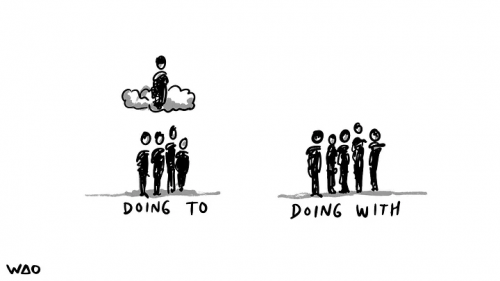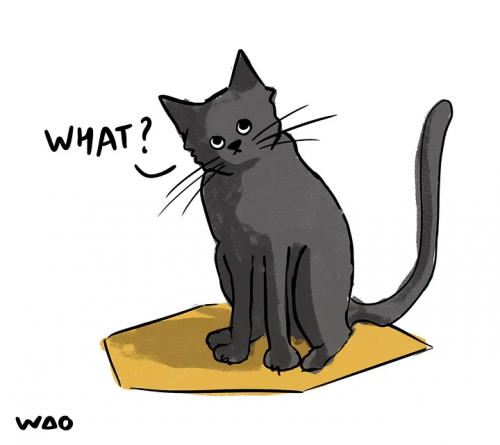Insights into WAO’s coaching techniques for effective presentations and workshops
One of the most rewarding aspects of our work is collaborating with organisations that are passionate about making a positive impact in the world. Earlier this year, we had the opportunity to work with Change.org to support them with workshop design and presentation development. In this post we’ll share some of the techniques we used to help, so you can use them in your organisation, too!

Change.org is a global platform that empowers people to create change in their communities and beyond. Their mission is to build a world where no one is powerless and where creating change is a part of everyday life. With this mission, it’s no wonder that they wanted the workshops and presentations of their 2023 offsite to empower people.

At Change, we have a unique opportunity to give a more powerful voice to hundreds of millions of people in order to build more participatory and responsive democracies. We want to live up to our mission and incorporate these principles into everything that we do so that we can create tools and resources that are authentic for people using our platform. We know that being involved in digital activism takes courage, intention and planning, many of the soft skills that we hope to strengthen internally amongst our Product Team. — Jess Klein, Director of Design
We’ve created slide decks for creating, preparing, running, recovering from sessions as well as one for general tips. This post gives just a brief overview of each section and pulls out the key questions you will want to ask yourself. If you’d prefer to see these tips all at once check out our monster slide deck!
Creating your session plan
Speaking and Facilitation: Tips & Tricks: Part 1
No-one likes a boring speaker or workshop. So your aim should be to create a session that is participatory, so that you can co-design solutions and outputs with others. “Participatory” means that a workshop invites input. Instead of “presenting” information, the facilitator asks participants to help solve problems.
Using participatory practices leads to better solutions, more inspiration and more collaboration. Creation isn’t passive, and “participatory” does not mean formless. A structure we like to use in workshops can be summarised as “Future, Present, Past”. You say what you’re going to do (future), do what you’re going to do (present) and then say what you did (past).
Here’s a list of questions to ask yourself when you are creating your session plan:
- How do you want people to feel in your session?
- What outputs do you want and why do these outputs matter to others?
- How can you ensure that everyone is able to contribute equally?
- How can you use your presentation or introduction to get people thinking?
- What can people DO that will help you move your work forward?
- What instructions can you give that guide the conversations and help your participants produce valuable insights?
- How can you time-box share outs so that each group gets a chance to share?
- How will you model this reflective activity for your participants?
- What can people do to stay involved with you and your work?
Create your slide deck
Speaking and Facilitation: Tips & Tricks: Part 2
Even in a participatory session, you’ll want to have some visual guidance. This will help people remember the reason they’re there and what problems they should be trying to solve. What you put on your screen isn’t there to prompt you but rather to prompt your audience.
Use stories, anecdotes, and analogies to bring your talk to life. Keep things visual as a picture paints a thousand words (and makes it easier for you to remember what you wanted to say!)
Question to think about for good deck of slides:
- What is essential for people to understand about your problem area so that they can contribute solutions?
- How can your slide deck serve your colleagues after the session?
- What questions do you want the audience to ask after you’re done presenting?

Promote your session
Now that you’ve spent so much time crafting your session, now you need to get people to attend. The more minds, the merrier! The best collaborative sessions include diverse perspectives to ensure that solutions and ideas speak to the broadest range of people.
You’ll want to tell people about your session, so that you get lots of input and lots of output. Don’t be afraid to promote your excellent planning!
Questions to consider:
- Who are your allies?
- Can you summarise the context, need and outcome in just 3 bullets?
- How can your entire organisation or sector benefit from the outputs of your session?
Run a mini pre-mortem

There are some things we can control and some things that we can’t. Thinking about what could go wrong in advance is a good way to prepare yourself for different eventualities. Some things we can prevent, whereas some things we can only mitigate. For example, we might be able to prevent the session running over, but we would only be able to mitigate a problem with the room we’re scheduled to be in.
Running a mini ‘pre-mortem’ creates a psychologically-safe space to take a look at your session and inherent risks. All you do is imagine it’s after the session is over and imagine that the session was a failure. The job of the pre-mortem is to identify in advance why that might happen.
Questions to help you create backup plans:
- What will you do if your slides are corrupt or there’s no paper in the room?
- Who can you call on to help remove / calm down someone who is exhibiting (sustained) problematic behaviours?
- How can you structure your slide deck to make sections skippable?
Take care of yourself
Every session needs at least one leader, and that’s you! So take care of yourself so you can help lead everyone through the session.
What that looks like in practice can depend on specific circumstances, but in general means a calm, well-rested person, with a plan and the resources to carry it out. If you’re part of a team running the session, then you should encourage them to be calm and well-rested, too.
Help yourself find calm:
- Are there particular things (e.g. coffee, energy drinks) that you know you should avoid directly before the session because of the effect they have on you?
- How long will each part of the session take, realistically?
- Do you need to factor in transition time?

Next steps…
In this post we’ve talked about planning, preparing, and promoting your session, as well as thinking about what could go wrong, and looking after yourself. What resonates with you? What do you need to work on in particular?
In our next post, we’ll talk about running and recovering from your session. We’ll also give you some general tips for a kick-ass workshop or presentation.